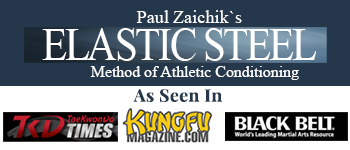Anatomy Kinesiology of the Axe Kick
Today we are going to learn the kinesiology of an Axe kick. This kick can be thrown with a rear leg or the front leg. The Axe kick comes down on the target in its basic form. While looks like a simple kick, it has many variations. It can come from inside out or outside. Thrown at angles, with open or square hips. Some styles prefer a specific variation of the kick, as do individual practitioners. The flexibility of the kicker, height, preferred fighting distance, other techniques in the arsenal are some of the factors which will decide, how your Axe is thrown.
In this article a rear, right leg axe kick is analyzed, front an orthodox Stance.
Phase One - Preparation for the Kick.

The legs are bent and the center of gravity drops. The Quadriceps are primary muscles that take the pressure. Rear leg Calf is activated. The torso rotate to the left. Right external and left internal Obliques perform this rotation. Right Gluteus Maximus, assisted by the Quads, Hamstrings and Calf push the body forward.
As the mass of the body is thrust forward, rear Hip Flexors and Adductors lengthen. Right internal and left external Obliques stretch due to rotation. This rotation will be used to lunch the right hip forward.
Phase Two - Approaching the Target

Right leg is raised over the target. Left hip is turned out. The torso can either be sideways or squared to the target. Right Hip Flexors and Adductors flex the hip, while the Auadriceps keep the knee extended. Slightly flexed supporting leg calls for the tension in Quadriceps and Calf. Gluteal Group may also fire, especially if the pelvis is tilted laterally to allow the right side of the pelvis to rise.
Right Hamstrings will bear the brunt of the stretch. While Gluteus Maximus and Extensors Part of the Adductor Magnus will also lengthen. Depending on the torso position, other muscles may also lengthen. For example Piriformis stretches if the torso is squared to the kicking leg or other Adductors, besides Magnus if the kicking leg is on the side of the body. Adductors of the standing leg will be stretched, and even more so if the femur is turned out.
Phase Three - Striking The Target

Hamstrings will be the primary muscle to execute the kick. It works both as the extensor of the hip and as the flexor of the knee or at least as the stabilizer of the knee against hyper extension. Adductor Magnus and Even Adductor Longus are also well positioned to drive the leg down. Gluteus Maximus however is not in the best position. While it's a very powerful extensor of the hip, at such high degree of flexion, it's not a major player. There is a way to improve power in the kick and perhaps recruit more muscles in their primary ranges. To do this, one must lean back during the last phase of the kick. This puts muscles into more advantageous positions to pull and at the same time drives the center of gravity forward. This also increases the reach of the kick.
Leaning back engages the flexors of the core. Obliques, Rectus Abdominis and Psoas Minor. At the same time the Hip flexors and upper Adductors of the supporting leg get engaged. The amount of participation in relation to each other (Hip Flexors vs Adductors) will depend on the degree of the supporting leg turn out. More turn out will involve the Adductors more. Less turnout will involve the Hip Flexors more.
© ElasticSteel Corp., EasyFlexibility, Paul Zaichik, et. El., 2022. No part of the materials available through ElasticSteel.com, EasyFlexiiblity.com, site may be copied, photocopied, reproduced, translated or reduced to any electronic medium or machine-readable form, in whole or in part, without prior written consent of Paul Zaichik EasyFlexibility.com, Elasticsteel.com.. Any other reproduction in any form without the permission of Paul Zaichik EasyFlexibility.com, Elasticsteel.com is prohibited. All materials contained on this site are protected by United States copyright law and may not be reproduced, distributed, transmitted, displayed, published or broadcast without the prior written permission of Paul Zaichik, EasyFlexibility.com, Elasticsteel.com.



Comments
Leave a comment